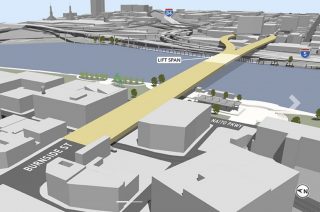
Multnomah County has released an online open house survey and needs your help to design a new Burnside Bridge. Their effort to create a new bridge that can withstand a major earthquake is currently in the environmental review stage. The review is focused on four options that have been whittled down from 100 that were studied since the project began in 2016.
The survey asks for feedback on several elements of the project including: the bridge design alternatives, the bridge cross-section, how to manage traffic during construction and the criteria to evaluate alternatives.
Three of the four remaining bridge designs (one of which they’re recommending to drop from consideration) would make the bridge wider in order to, “accommodate more space for bikes, pedestrians and transit.” Alternative #3 would “smooth out” the infamous Couch Street curve.
Advertisement
If the bridge is replaced (versus retrofitting the existing one) the cross-section would be about nine feet wider. In their current designs, the County would use that extra width to widen the bike lanes (to eight feet) and other vehicle lanes. They also show a concrete barrier that would separate the bike lane from the other lanes.
Take a look at the options and please consider sharing your comments. The open house and survey will be up through October 4th.
In related news… while the County won’t begin construction of this project until 2024, the City of Portland already has plans to move forward on a bus lane project on the Burnside Bridge as part of the Central City in Motion plan. That project would create a bus-only lane for three TriMet bus lines and widen the bike lanes in both directions, “opening the possibility of providing protected bike lanes.”
— Jonathan Maus: (503) 706-8804, @jonathan_maus on Twitter and jonathan@bikeportland.org
Never miss a story. Sign-up for the daily BP Headlines email.
BikePortland needs your support.




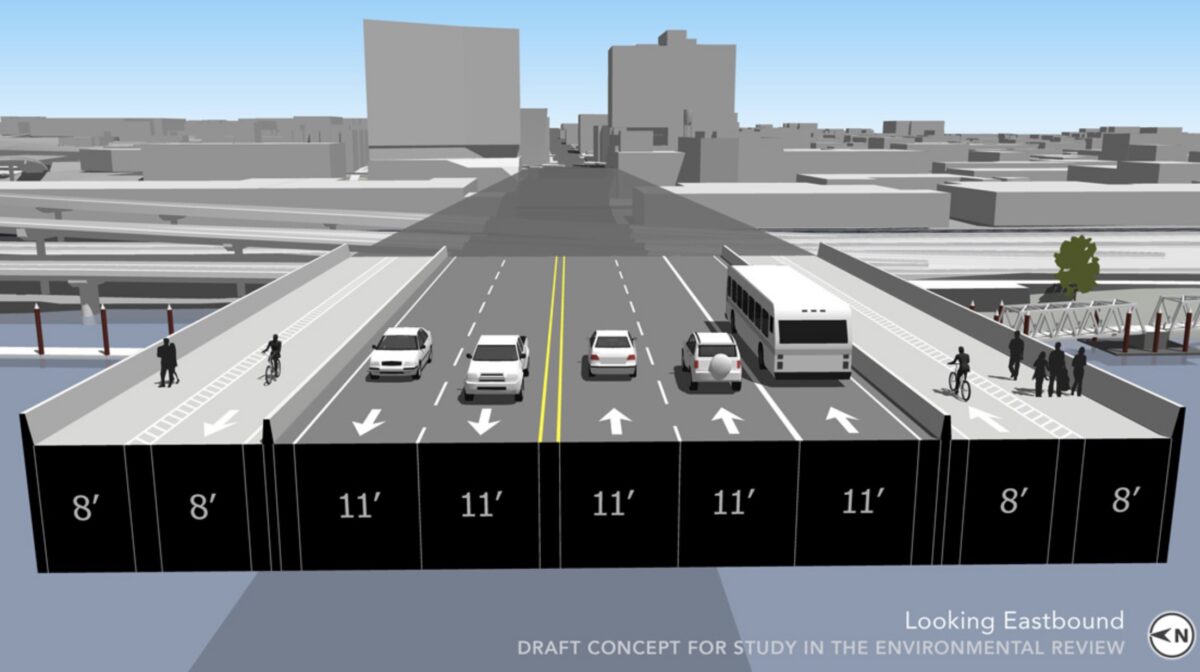
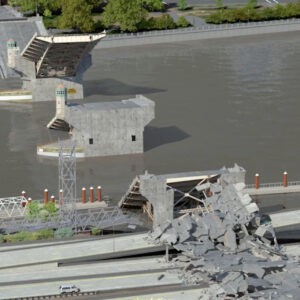
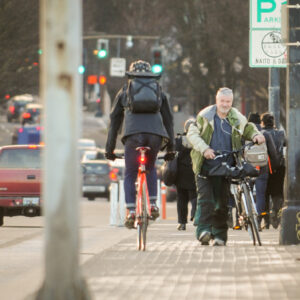
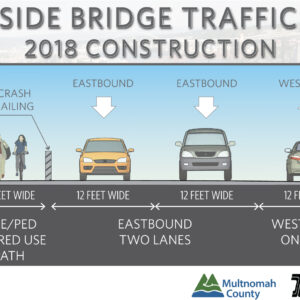
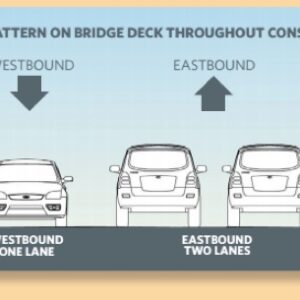
Thanks for reading.
BikePortland has served this community with independent community journalism since 2005. We rely on subscriptions from readers like you to survive. Your financial support is vital in keeping this valuable resource alive and well.
Please subscribe today to strengthen and expand our work.
Can we retrofit (i.e. narrower profile) and add a concrete barrier between cars and bikes?
Given the profile widths it looks pretty constrained. Maybe they could be protected if the bike lane was above the curb at sidewalk height that would also allow for cyclist to pass similar to the Hawthorne Bridge.
I had the same thought! Their cross section shows 8′ for pedestrians on both sides and 5’6″ for bike lanes on each side. I suggested in the survey that each side should instead have a 6′ sidewalk, a 5’6″ bike lane, a jersey barrier, and 1′ of shy distance between the jersey barrier and the auto lane. 5’6″ may be too tight for bikes to pass each other, but it will be fine outside of rush hour.
A little odd there were no budget estimates because I assume the retrofit is a substantial time/money savings over the other options.
Also, need to make sure that Burnside Skate Park is not destroyed!
(A) Closing the bridge for several years or (B) spending $100 million to build a temporary bridge both seem like really bad options. For reference, the Tilikum Crossing cost $135 million.
Why not kick in an extra $50 million upfront and build a permanent 3-lane bridge on Couch street? During construction of the Burnside bridge it could carry the bus lane and one lane in each direction. Then the Burnside bridge would only need to be replaced with a 3-lane bridge instead of 5. This wouldn’t reduce costs by 40%, but maybe by 20%? That seems achievable, right? So in the end, you’d have two bridges, each with two traffic lanes and a bus lane. The cost seems like it would be a wash, or even cheaper than what’s being proposed (especially if you compare it to Alternative 3, in which the Couch bridge already extends out half the distance). We wouldn’t need to implement the west Couch couplet, it could rejoin Burnside at 3rd or Broadway.
I’m genuinely puzzled why this isn’t one of the alternatives. Maybe a permanent Couch street bridge would cost much a lot more than the Tilikum bridge or a temporary bridge (though, why?)? Or maybe it’s impacts to waterfront park?
Anyone know if this was considered, and why it wasn’t carried forward?
I like the way you’re thinking! I imagine that 2 permanent bridges would cost more than one permanent+one temporary bridge, but that’s just a WAG, would love to know how it would really pencil out. The idea of a bridge couplet is very cool and there is the potential for a nice realignment of Couch on the east side.
Imagine if we just replaced Burnside with a Tillikum-style bridge permanently. No SOV traffic at all. It would be open to emergency traffic so would solve that problem. And could go miles towards decreasing SOV use in our congested downtown. Think of THOSE cost savings!
Yeah, I can imagine how terrible that would be. There are already not enough East-West crossings with the increasing density of the inner city and growing downtown employment – removing the crossing that carries the most traffic (or is that the Morrison) would surely alleviate that problem….
So there aren’t enough east-west crossings, huh?
Back when the Tillikum was under construction and people were complaining that it didn’t include vehicle lanes, I took a close look at all the bridges in central Portland and counted the lanes.
The result? There are forty-three vehicle lanes crossing the Willamette between the Ross Island and Fremont bridges. Do you really think adding more will solve the problem?
I feel like they are driving it towards the temporary bridge solution. There are many bridge replacement projects out there that have managed to have the old bridge closed for just a few months. You build the supports as you assembly the new bridge, then demo the old bridge and slide the new bridge into place.
There may be some kind of limit because of water traffic. I’m not sure exactly how bridges get raised, but there may be staffing requirements that would make your two-bridge proposal more expensive.
Staffing requirements? I was under the impression most of the county bridges are remotely controlled.
Two identical parallel bridges could use the same design, designed once, with only minor adjustments, if any, for the foundations in the River.
Not much gap between buildings on Couch at the east side:
https://goo.gl/maps/VoVTLpZs44NGqf7aA
Then I-5 to get over: https://goo.gl/maps/ohQvVEFDGD63oRBG6
Bridge redundancy is a good thing.
Too many vehicle lanes not enough transit lanes. Eliminate one vehicle lane for a transit lane and make the middle lane reversible for rush hour and closed the rest of the time. Move people, not cars with one person in them.
I assume that a retrofit would be much cheaper than a new bridge, which is good. However that cross-section is a terrible use of the width that’s available. The width occupied by the third Eastbound lane should reallocated for wider, protected bike lanes. Also bus lanes.
I made a quick little graphic of what this alternative cross-section ought to look.
https://drive.google.com/file/d/1pc-8QpnSSm071zRw7DUgiWeq2PNmjBul/view?usp=sharing
I think this is the best design so far. We need to choke the motor vehicles and give plenty of room for active transportation.
Feedback submitted.
I stated that they should retrofit the current bridge and leave only one lane in each direction for the transportation modes of: motor vehicle, bus, bicycle, and sidewalk.
Message nesting fail. I miss the old system that let you know you were still in a thread when you posted.
If we’re going to go to the trouble of building a new bridge, it should be ready to serve as a BRT route at some point in the near future. So, two dedicated transit lanes, with the capacity to lay down streetcar tracks also.
Why on earth would they widen the vehicle lanes? People drive way too fast on the Burnside as it is!
Trucks and buses. 11′ is the default minimum for large vehicles and their mirrors.
Submitted feedback! Including comments I gleaned from these comments, like the idea of a Couch bridge instead, and 10′ lanes being plenty for a city, which helps makes a refurbished bridge (my preference) more feasible.
(PS Jonathan I’m finally a proudly paying BikePorlander, but I’m not seeing my badge of honor under my avatar icon. Is there anything to be done about that?)
Feedback submitted.
I stated that they should retrofit the current bridge and leave only one lane in each direction for the transportation modes of: motor vehicle, bus, bicycle, and sidewalk.